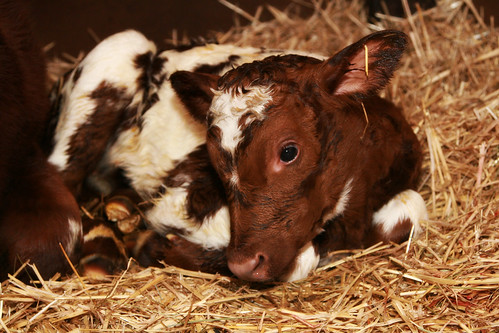It has been a very busy past couple of weeks. I am a very happy farmer with babies of all types running around. Though we have been busy, the craziness has been cut with moments of watching the goat kids jumping around full of new life. And so, I EXPECTED to start milking again on March 1, come hell or high water. Of course, we experienced both hell and high water. This crazy early spring has reinforced my belief that the only constant in this farming gig is that things never happen as you expect them to. I apologize deeply for the lack of communication, but I’ve got some good news.
I have decided to reorganize our milking stock to more exactly meet our dairy goals. After careful examination, it was decided that our cow Daisee does not fit into our program. This was a tough decision. Hand milking the cows means that I spend a lot of time with them, and I like to think that I have a special relationship with them. Deciding to sell a cow feels a little bit like deciding to sell one of my children. However, we are limited to three cows in our dairy, and no matter how I look at it, Daisee just can’t stay. She is going to make someone a very nice milk cow, and in fact, it looks like she’ll be going to California to do just that. She will be missed.
With that decision made, we have moved on and have purchased two more cows for our dairy program. I am over the moon with excitement about this decision for many reasons. We are committed to working with the heritage breeds of livestock. This is why the Milking Shorthorns have been so appealing to me. I raised beef Shorthorns as a kid, and I had always wanted a Milking Shorthorn. It made sense to use this breed to start out our milking program, as there are only 3000 cows left in the American Registry. Due to the wonders of AI, I have been breeding and raising registered, Native Bred Milking Shorthorns. What does this mean? Well over the past several years, the Milking Shorthorn registry decided to open it’s herd books to cross breeding with Holsteins. This was done to up the milk production of the Milking Shorthorns so that they would again start to look appealing to commercial dairies so that the breed would not completely disappear. While I have nothing against Holsteins, they are not Milking Shorthorns. Luckily, the registry decided to track those lines that were not mixed with outside blood. My cows are of the pure line, which means that they go back to the first dairy cows brought over from England used by small farmers as triple purpose breeds. I love working with this breed and plan to continue to. Our Milking Shorthorn cow, Fancee, is staying in our program.
Enter, our new cows. These cows are both heritage breeds, but the kicker is that they are not the same breed! We are getting a beautiful golden Guernsey named Tillie and a beautiful Brown Swiss named Clover. I am over the moon with excitement about these girls because we are now not only working with one heritage breed, but three! These are the three breeds of cows that are slowly dying and falling out of favor with commercial dairies because they often can’t compete with the high production rates of the Holesteins or the butterfat content of the Jerseys. I was lucky enough to find two cows with good production level and decent butterfat. My first milk cow years and years ago was a Guernsey named Bridget. Bridget and I did well in the show ring, and she has always been in the back of my mind. Guernseys have become rare and hard to find. The people that own them know how valuable they are and are not selling them. It has taken me 3 years to find a Guernsey and convince it’s owner to let her go! Brown Swiss are graceful cows with high production. Clover will be my first Brown Swiss cows, but I cannot wait to get to know this cow.
Purchasing these cows does two important things for our dairy. Firstly, we will now be milking a high quantity of quality milk. This will allows us to raise our calves on real milk without outside supplementation. It also allows us to take on enough milk customers to make this endeavour financially viable. Secondly, we are transitioning our herd over into an A2 herd. Haven’t heard of A2 milk? Here is a small bit of info to get you caught up. http://www.a2milk.com/ Basically, milk used to all be A2 milk, after a genetic mutation, cows started producing A1 milk, and these cows happened to also be high producers. Dairymen caught on and started selecting out those cows/bulls for breeding, and the milk with the A1 mutation became overwhelmingly the norm. Luckily, our decision to work with heritage breeds also leads us down the path of getting good, quality A2 milk. Keeping our ancient genetic lines true means that we are headed down the path of having unique and healthy A2 milk. While some call the A2 milk a marketing trend, none refute the benefits of having milk that is more nutritionally available to those who consume it.
And so, this is all a very long winded method of apologizing for the delay in milk but that the wait is going to be worth it!
We will have milk available starting on Sunday morning. Plan to pick up on your regular day starting this Sunday. You might want to plan a few extra moments to see all the new babies around (we will be expecting Fancee’s calf mid April, so there is that to look forward to as well. Oh.. and since we have a lot of milk available now, tell your friends. You get two free gallons of milk for everyone you bring into our CSA. Feel free to email or call with any questions!


